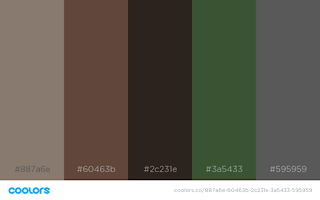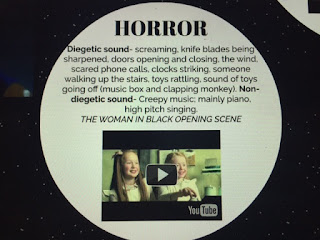For part of my research for my groups opening scene, I have been finding photos, video clips, and words that best describes four genres of film that I have chosen to explore. I have chosen Horror, Comedy, Romantic and Action, as these genres are my favourite kinds of films, which I would be interested in using to make my final piece of coursework.
I have created a moodboard of how I interpret films from each of these genres, giving me an idea of what we might need to include for our chosen genre, opening scene clip.
You can view my moodboard below:
When navigating your way around my moodboard, you can click on the 'YouTube' sign on the bottom, right hand side of each of the clips I have as part of my research, where you can watch an example that I have found for an opening scene to all of these genres.
Here are snapshots of my moodboard:
My whole moodboard shows what my idea of the main aspects are, in each of these genres. I have included photos from the movies that are the genre shown, also words/ things that are relevant to these types of films. For example- for Horror; blood, haunted houses, scary masks, abnormal things, dolls, knives and strange, black figures are what I know are shown most frequently in this type of genre of film. Also video clips of YouTube.
As you can see, I named the types of diegetic and non-diegetic sounds that I could think of that are of normal occurrence in a horror movie.
If we were to create a horror movie opening scene, we would probably use some of these sounds to make the genre stand out when viewing.
For an example of a horror movie opening scene, I chose 'The woman in Black' as I felt that this opening scene was very spooky and builds tension, as that is what I think most horror movies are all about.
The idea of having a shot of little children, almost dressed as dolls, playing with dolls at a pretend tea party, gives a sense of creepiness to the scene.
The non-diegetic background music also creates a very 'mystic' atmosphere as the sound of many classical instruments together form a very dark and demented sound. I feel that this music creates suspense for the viewers and keeps them on their seat to see what is about to happen.
There is a vast range of camera angles and shots used, but mainly medium shots, and also close up shots when the girls drop the tea cup, tread on the tea pot and dolls head, and head towards the window, which they all then jump out from. The opening scene ends in a blood curdling scream.

Romantic genre films, such as 'Valentine's day' which I used as an example for an opening scene, are filled with kisses, flirting, laughing and being all 'loved up'.
In a lot of opening scenes to romantic films, you see a romantic gesture being done such as a proposal, an amazing gift being brought for the loved one and flowers being brought. All of these things could be said to signify love.
The non-diegetic sound in romantic films are normally quiet, mellow songs, or songs actually about love. These songs give a romantic feel to the film and makes the viewer feel the love that is being shown throughout the film, or in a specific film. The typical scene that would need that type of music is when a couple kiss for the first time, or dance together under the stars, or even just lying in bed together.
The
mes en scene present in most romantic films are light coloured clothing, suggesting happiness, also props such as a wedding ring, or massive teddy bear as a gift. These things are what a typical romantic film would include.
The
'male gaze' theory by Laura Mulvey suggests that women are seen as sex icons for men. In most romantic films, this theory is demonstrated by a lot of women being shown in little clothing and propped in sexual positions.
When I researched some action movies, the diegetic sounds that came to my head were loud and fulfilling sounds, such as gun shots, explosives, car crashes etc. These sounds best describe what happens most in an action movie... Action!
For an example of an opening scene to an action movie, I chose James Bond- Quantum of Solace, as this film has lots of action present. The opening scene shows close up of fast cars racing, mens face, and people shooting guns out of their car windows. These types of actions shown create suspense and thrill for the viewers, as everything is happening so fast and is shown in fast shots, mainly close up shots, but also medium and long, continuous shots. All of these camera shots are acceptable when filming an opening to a film and this gives me a rough idea of how we could piece together an opening scene to an action movie.
Comedy films are made to make people laugh so the main aspect, I think, of an opening scene to a comedy is to draw in the viewers straight away by having lots of laughable moments right at the beginning.
An example of this is the video that I implanted onto my moodboard of Bridget Jones lip singing to "all by myself". This is funny because of the irony- she is alone and doesn't want to be. She is also very dramatic which is what the viewers enjoy seeing when they watch a comedy film. A lot of comedy films are full of hidden jokes inside of what people say, that only some people may understand, and thats what makes it more humorous! The main camera shots used in comedy films are medium shots, and a few close ups if the actor is doing something funny, or even to show a facial expression. Depending on what the comedy is about, a lot of comedy films feature adults acting like children and sometimes children acting like adults, the abnormality of this creates a comical atmosphere. A lot of the diegetic sounds present in a comedy film are disgusting noises, which people might find funny- such as burps and farts. Again, because people tend to be quite discrete about these types of noises, some people find it amusing when they hear them regularly in a film.



















